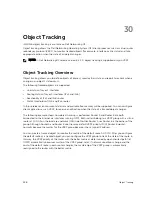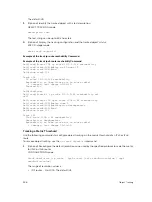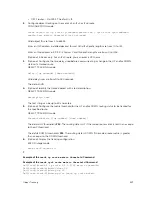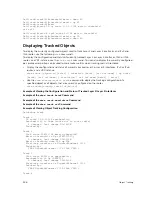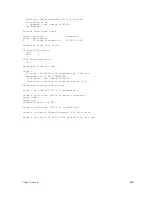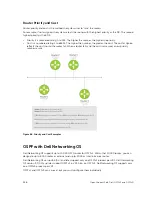
EXEC Privilege mode
show track
object-id
Example of Configuring Object Tracking (IPv4 Interface)
Example of Configuring Object Tracking (IPv6 Interface)
Dell(conf)#track 101 interface tengigabitethernet 7/2 ip routing
Dell(conf-track-101)#delay up 20
Dell(conf-track-101)#description NYC metro
Dell(conf-track-101)#end
Dell#show track 101
Track 101
Interface TenGigabitEthernet 7/2 ip routing
Description: NYC metro
Dell(conf)#track 103 interface tengigabitethernet 7/11 ipv6
routing
Dell(conf-track-103)#description Austin access point
Dell(conf-track-103)#end
Dell#show track 103
Track 103
Interface TenGigabitEthernet 7/11 ipv6 routing
Description: Austin access point
Track an IPv4/IPv6 Route
You can create an object that tracks the reachability or metric of an IPv4 or IPv6 route.
You specify the route to be tracked by its address and prefix-length values. Optionally, for an IPv4 route,
you can enter a VRF instance name if the route is part of a VPN routing and forwarding (VRF) table. The
next-hop address is not part of the definition of a tracked IPv4/IPv6 route.
In order for an route’s reachability or metric to be tracked, the route must appear as an entry in the
routing table. A tracked route is considered to match an entry in the routing table only if the exact IPv4 or
IPv6 address and prefix length match an entry in the table. For example, when configured as a tracked
route, 10.0.0.0/24 does not match the routing table entry 10.0.0.0/8. Similarly, for an IPv6 address,
3333:100:200:300:400::/80 does not match routing table entry 3333:100:200:300::/64. If no route-table
entry has the exact IPv4/IPv6 address and prefix length, the tracked route is considered to be DOWN.
In addition to the entry of a route in the routing table, you can configure the UP/DOWN state of a tracked
route to be determined in the following ways:
• By the reachability of the route's next-hop router.
The UP/DOWN state of the route is determined by the entry of the next-hop address in the ARP
cache. A tracked route is considered to be reachable if there is an ARP cache entry for the route's
next-hop address. If the next-hop address in the ARP cache ages out for a route tracked for its
reachability, an attempt is made to regenerate the ARP cache entry to see if the next-hop address
appears before considering the route DOWN.
• By comparing the threshold for a route’s metric with current entries in the route table.
The UP/DOWN state of the tracked route is determined by the threshold for the current value of the
route metric in the routing table.
544
Object Tracking
Summary of Contents for Z9000
Page 1: ...Dell Configuration Guide for the Z9000 System 9 7 0 0 ...
Page 80: ...grub reboot 80 Management ...
Page 128: ... 0 Te 1 1 Te 1 2 rx Flow N A N A 128 Access Control Lists ACLs ...
Page 491: ...Figure 70 Configuring OSPF and BGP for MSDP Multicast Source Discovery Protocol MSDP 491 ...
Page 496: ...Figure 73 MSDP Default Peer Scenario 1 496 Multicast Source Discovery Protocol MSDP ...
Page 497: ...Figure 74 MSDP Default Peer Scenario 2 Multicast Source Discovery Protocol MSDP 497 ...
Page 498: ...Figure 75 MSDP Default Peer Scenario 3 498 Multicast Source Discovery Protocol MSDP ...
Page 760: ...Figure 100 Single and Double Tag TPID Match 760 Service Provider Bridging ...
Page 761: ...Figure 101 Single and Double Tag First byte TPID Match Service Provider Bridging 761 ...









